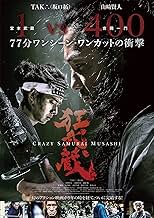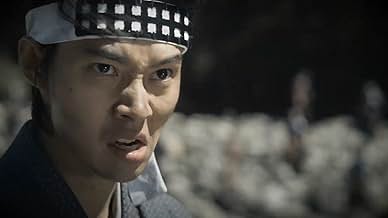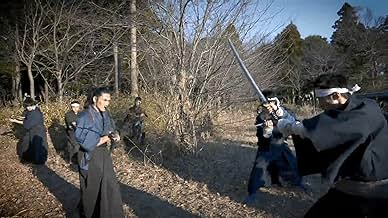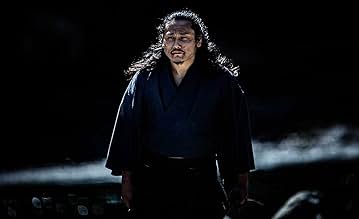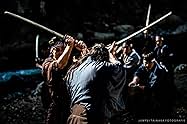AVALIAÇÃO DA IMDb
4,6/10
1,1 mil
SUA AVALIAÇÃO
Em 1604, no Japão feudal, cem membros da família Yoshioka contratam trezentos mercenários para derrotar o lendário samurai Miyamoto Musashi.Em 1604, no Japão feudal, cem membros da família Yoshioka contratam trezentos mercenários para derrotar o lendário samurai Miyamoto Musashi.Em 1604, no Japão feudal, cem membros da família Yoshioka contratam trezentos mercenários para derrotar o lendário samurai Miyamoto Musashi.
Avaliações em destaque
Totally unrealistic.
95% of the actors who supposedly get killed either fall behind a tree/building, get concealed by a couple of other actors, or stumble out of the camera field of view. Only to reappear minutes later.
When the camera eventually pans around only 2-3 bodies are there instead of a pile of around 60+ corpses.
You end up watching the same repeated sequence over and over... one person at a time attacks, gets pommelled on the head, crawls off screen, and reappears a few minutes later.
I guess due to the lack of actors involved this was necessary, but this is child's playground fare in its execution. An army being represented by a dozen or so people constantly running around the cameraman is beyond acceptable.
95% of the actors who supposedly get killed either fall behind a tree/building, get concealed by a couple of other actors, or stumble out of the camera field of view. Only to reappear minutes later.
When the camera eventually pans around only 2-3 bodies are there instead of a pile of around 60+ corpses.
You end up watching the same repeated sequence over and over... one person at a time attacks, gets pommelled on the head, crawls off screen, and reappears a few minutes later.
I guess due to the lack of actors involved this was necessary, but this is child's playground fare in its execution. An army being represented by a dozen or so people constantly running around the cameraman is beyond acceptable.
A good samurai movie. It does contain the longest fighting sequence, in a single shot! Fighting does feel repetitive, but you can't compare it to anything else, cuz no one else did the same thing.
Real dedication showcased. I wish they had longer first and last scenes, and a shorter fighting sequence in between.
Very cool to pull a "one shot" off, but man did it ever trade that for the things I expect in a hardcore samurai movie. Not even ONE decapitation. So sad...
There is very little effort made in setting up how or why the fight happened and so as a story the plot (i.e. the central conflict) is lacking. Man v. man, yes, but without setting it up there's no real story here. I'm happy I bought it and watched it as encouraging innovation in chambara or jidai geki (definitely the former). As entertainment it lacks because it goes on long enough to spot some glaring issues easily ignored in shorter scenes. 1) the shortest distance between two points is a line. From the middle stance, one is always threatening the throat strike as the most efficient killing blow but he never does it. I get it for safety's sake but after so much coverage it becomes more obvious. 2) no one who charges from the high stance has any actual intent to connect the downward swing. You can tell because he's easily able to connect a slice to the midriff (should be a "men" attack probably) before the downswing ever happens. He does this without needing to step forward or do anything to throw off their timing. 3) no coordination from the attackers. The very few times they attack simultaneously, it's high so both blows can be blocked with the same block. The only way they could have won would be such simultaneous attacks but from different angles & directions. I take issue with those who say no blood gets on his blade because it's manifestly inaccurate. I agree with those who say that the few extras in the exact same outfits & hairpieces is something easily perceived after so many minutes of coverage.
Things that still impress me 1) the actor's physical stamina. Even if the "sword" is light wood, it has to be heavy enough to receive a lot of blows without visually bending or distorting. The actor holds that thing up an impressive length of time. We used to do an exercise in my Okinawan style where we would hold our arms parallel to the ground for as long as we could and it was never long. We just couldn't do it. 2) the preparation of the character for the battle in advance. He knows he'll need extra swords & water, so he set them up in advance. I'd like to circle back to the actor's stamina here because until close to the end he drinks very little of the water, preferring to rinse his mouth & his "blade." He's obviously sweating for real & doing a lot off physical activity so again, impressive. 3) the fight scene at the end.
The last bit of criticism I have wasn't mentioned yet, and that is not letting us see the last opponent defeated. After making us sit through all that attacking without even giving us the emotional satisfaction of completion felt like a deliberate waste of our time. If they were going to cut away, why not edit? Why not show the ending after spending so much time setting it up.
Things that still impress me 1) the actor's physical stamina. Even if the "sword" is light wood, it has to be heavy enough to receive a lot of blows without visually bending or distorting. The actor holds that thing up an impressive length of time. We used to do an exercise in my Okinawan style where we would hold our arms parallel to the ground for as long as we could and it was never long. We just couldn't do it. 2) the preparation of the character for the battle in advance. He knows he'll need extra swords & water, so he set them up in advance. I'd like to circle back to the actor's stamina here because until close to the end he drinks very little of the water, preferring to rinse his mouth & his "blade." He's obviously sweating for real & doing a lot off physical activity so again, impressive. 3) the fight scene at the end.
The last bit of criticism I have wasn't mentioned yet, and that is not letting us see the last opponent defeated. After making us sit through all that attacking without even giving us the emotional satisfaction of completion felt like a deliberate waste of our time. If they were going to cut away, why not edit? Why not show the ending after spending so much time setting it up.
Miyamoto Musashi was a very interesting Japanese Ronin in Japan's era's of swordsmen and Samurai history. Throw in Tak Sakguchi playing Musashi and I was all set for an amazing action film. How wrong I was!
It dragged on and on with poor fight choreography and too few extras playing his enemies (it became very apparent, after 10 minutes, that the same dead guys were coming back time and time again). There were no exiting moments, no edge of your seat grippers but, there were many sword style errors; which in real life he would have been killed.
Overall i think it was poorly conceived, directed and acted with terrible choreography.
A brief HISTORY of the warrior who was the Bruce Lee of ancient Japanese swordsmen. Miyamoto Musashi, also known as Shinmen Musashi no Kami Fujiwara no Harunobu, Shinmen Takezo, Miyamoto Bennosuke or, by his Buddhist name, Niten Doraku, was a Japanese swordsman, philosopher, strategist, writer and Ronin. Musashi, as he was often simply known, became renowned through stories of his unique double-bladed swordsmanship and undefeated record in his 61 duels. He is considered a Kensei, a sword-saint of Japan. He was the founder of the Niten Ichi-ryu, or Nito Ichi-ryu, style of swordsmanship, and in his final years authored The Book of Five Rings and Dokkodo. Both documents were given to Terao Magonojo, the most important of Musashi's students, seven days before Musashi's death. The Book of Five Rings deals primarily with the character of his Niten Ichi-ryu school in a concrete sense, i.e., his own practical martial art and its generic significance; The Path of Aloneness, on the other hand, deals with the ideas that lie behind it, as well as his life's philosophy in a few short aphoristic sentences. Born:Shinmen Bennosuke, c.1584, Harima Province or Mimasaka Province, Japan. Died:June 13, 1645, Higo Province, Japan.
A brief HISTORY of the warrior who was the Bruce Lee of ancient Japanese swordsmen. Miyamoto Musashi, also known as Shinmen Musashi no Kami Fujiwara no Harunobu, Shinmen Takezo, Miyamoto Bennosuke or, by his Buddhist name, Niten Doraku, was a Japanese swordsman, philosopher, strategist, writer and Ronin. Musashi, as he was often simply known, became renowned through stories of his unique double-bladed swordsmanship and undefeated record in his 61 duels. He is considered a Kensei, a sword-saint of Japan. He was the founder of the Niten Ichi-ryu, or Nito Ichi-ryu, style of swordsmanship, and in his final years authored The Book of Five Rings and Dokkodo. Both documents were given to Terao Magonojo, the most important of Musashi's students, seven days before Musashi's death. The Book of Five Rings deals primarily with the character of his Niten Ichi-ryu school in a concrete sense, i.e., his own practical martial art and its generic significance; The Path of Aloneness, on the other hand, deals with the ideas that lie behind it, as well as his life's philosophy in a few short aphoristic sentences. Born:Shinmen Bennosuke, c.1584, Harima Province or Mimasaka Province, Japan. Died:June 13, 1645, Higo Province, Japan.
Você sabia?
- CuriosidadesActor Tak Sakaguchi broke one finger, one rib and four of his teeth during the 77 minute battle sequence.
- Erros de gravaçãoMusahashi couldn't have known where to immediately find something to drink for each of his several breaks in a deserted village on the other clan's turf.
Principais escolhas
Faça login para avaliar e ver a lista de recomendações personalizadas
- How long is Crazy Samurai Musashi?Fornecido pela Alexa
Detalhes
- Data de lançamento
- País de origem
- Central de atendimento oficial
- Idioma
- Também conhecido como
- Crazy Samurai Musashi
- Empresas de produção
- Consulte mais créditos da empresa na IMDbPro
- Tempo de duração1 hora 31 minutos
- Cor
- Proporção
- 1.78 : 1
Contribua para esta página
Sugerir uma alteração ou adicionar conteúdo ausente


